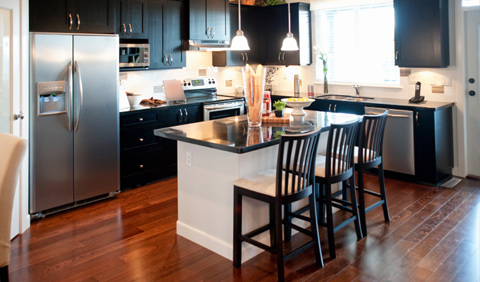There are a variety of ways to improve the energy efficiency of your kitchen, starting with the way you use your appliances to home sealing and replacing your light fixtures.
Floor Vents/Radiators
- Ensure vent connections and registers are well sealed at floors, walls and ceilings, which are all common areas for disconnected ducts and leakage.
- Make sure all floor vents and air registers are clear of furniture, allowing air to flow freely.
- Install heat resistant reflectors between radiators and walls to reflect heat back into the room instead of onto walls.
Range
- Use the right sized pots with stove burners; for example, a 6″ pot on an 8″ burner wastes over 40% of the heat generated.
- Cover pots and pans when cooking to keep heat in.
- Learn more:
- Save up to $36 annually on electric ranges or $18 on gas by simply using the right sized pots on burners.
- Cook more efficiently and keep your kitchen cooler by covering pots and pans.
- Keep gas range burners clean to ensure maximum efficiency.
Range Hood
- Install ENERGY STAR certified range hoods to control moisture and remove cooking odors.
- Learn more:
- On average, ENERGY STAR certified ventilation fans use 60% less energy than standard models.
- Save more than $60 in electricity costs over the life of a fan by replacing it with an ENERGY STAR certified one.
- By using high performance motors and improved blade design, ENERGY STAR certified fans are quieter, perform better and are longer lasting than standard models.
- Look for ENERGY STAR certified range hoods at home improvement and hardware stores, or ask for them from your HVAC or electrical contractor.
Microwave
- Use your microwave to reheat or cook small portions.
- Learn more: Reduce cooking energy by up to 80% by using the microwave for small portions.
- Using the microwave can help save on A/C costs in summer as it generates less heat than a conventional oven or stove.
Cordless Phones
- Save energy by using ENERGY STAR certified cordless phones that feature switch-mode power supplies and “smart” chargers.
Dishwashers
- Save water by scraping instead of rinsing dishes before loading the dishwasher.
- Run your dishwasher with a full load.
- If available, use the air-dry option.
- Learn more:
- Rinsing dirty dishes is a waste of water and energy; most dishwashers today are able to thoroughly clean scraped dishes.
- To use your dishwasher efficiently, run it only when you have enough dirty dishes for a full load.
- Appliances account for about 12% of your energy bill, so replace outdated models with newer, more energy efficient ENERGY STAR certified versions.
- Pledge to buy an ENERGY STAR certified dishwasher.
Light Fixtures
- Install ENERGY STAR certified light fixtures and replace standard light bulbs with compact fluorescent light bulbs (CFLs), which generate less heat.
- Learn more:
- Kitchen light fixtures are among the most used in the home.
- ENERGY STAR certified lighting fixtures are available in many popular styles, such as cabinet and ceiling mounted versions, as well as recessed can models.
- ENERGY STAR certified light fixtures use 75% less energy, generate 75% less heat and last up to 10 times longer than standard lighting, while producing bright, warm light.
- Pledge to replace standard light fixtures and bulbs with ENERGY STAR certified lighting products.
Windows
- Caulk and weather-strip areas around doors and windows to prevent air leakage.
- Replace window screens with storm windows during winter as an extra barrier against cold air.
- Learn more:
- ENERGY STAR certified windows can save you anywhere from $150-$500 annually in energy costs.
- Cut drafts, increase home comfort and help preserve interior furnishings with properly installed ENERGY STAR certified windows.
- Pledge to apply caulk and weather-stripping around windows and doors that leak air.
Kitchen Sink
- Leaky faucets can result in gallons of water wasted, so take quick action to make any necessary repairs.
- Learn more:
- Hot water leaking at 1 drip per second adds up to 1,661 gallons of water wasted in a year.
- 1,661 gallons of water works out to approximately $35 in squandered energy costs.
Refrigerator
- Look for ENERGY STAR certified models when purchasing a new refrigerator.
- Lower energy consumption by cleaning out your fridge regularly to ensure proper air circulation.
- Don’t open the fridge door unnecessarily; every time you do, the temperature drops by 2-5 degrees Fahrenheit.
- For every 30 seconds the door remains open, it can take up to 30 minutes to restore the fridge to its original temperature.
- Learn more:
- A new ENERGY STAR certified refrigerator can run continuously on less energy than a 60-watt light bulb.
- ENERGY STAR certified refrigerators use at least 20% less energy than required by current federal standards.
- Refrigerators manufactured before 1993 use twice as much energy than newer models.
- By recycling or disposing of your old fridge, you can save anywhere from $300-$700 and prevent 5,500 to 20,000 pounds of greenhouse gas emissions.
Light Switch
- Always turn off the lights when leaving any room (or when it’s not in use).
Outlet
- Unplug any battery chargers or power adapters when not in use.
- Use inexpensive outlet gaskets to seal any holes around outlets.

